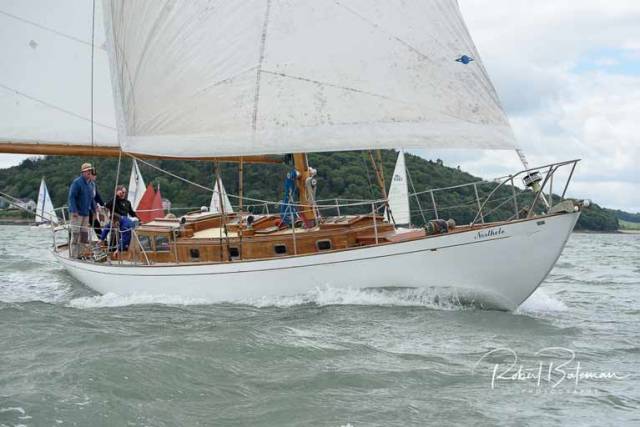If you were putting together a pub quiz about classic yachts, “Who was Sandy Balfour?” would be a very handy question to get the elementary section going writes W M Nixon.
Dyed-in-the-wool classics aficionados would roll their eyes in amusement at being asked something to which surely everyone knows the answer, contemptuously regarding it as an ignorant query about someone who, while not prolific, was an important creator of significant yachts with their own signature style.
But for those whose knowledge of the great classic designers is limited to the headline figures such as Watson, Fife, Herreshoff, Nicholson, Mylne, Reimers, Anker, Stephens and Rhodes, A K “Sandy” Balfour is probably off the screen.
Yet those who do have classic yachts from Balfour’s design board develop a very special fondness for their pride-and-joy. And this season, top Crosshaven racing campaigner Anthony O’Leary has become one of them with the acquisition of the 50ft Northele, a Balfour design of 1949 vintage.
She has been around Cork Harbour for some years now, but it was no secret, when she was put on the market, that a long winter of TLC in a skilled yard would in time be required to restore her complete and glorious classic potential. That particular project is going to be undertaken this winter in Castle Point Boatyard. But for now, Northele sits elegantly in style in full commission in Crosshaven, dressed overall in honour of Volvo Cork Week while her owner goes at it hammer and tongs in the 1720 racing.
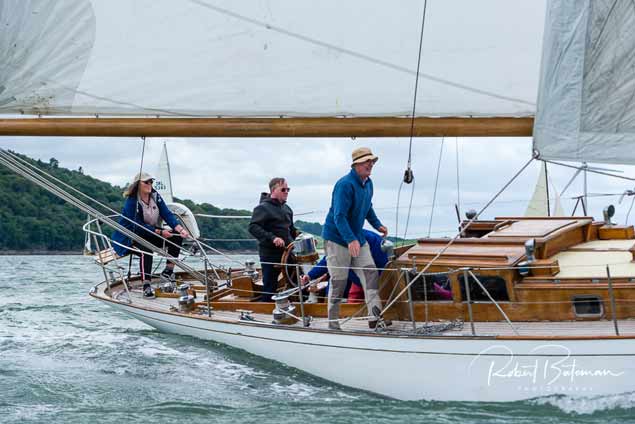 New owner Anthony O’Leary finds Northele is the kind of boat that restores your joy in sailing. Photo: Robert Bateman
New owner Anthony O’Leary finds Northele is the kind of boat that restores your joy in sailing. Photo: Robert Bateman
So who was Sandy Balfour? Born in Glasgow, after a boat-building apprenticeship with Harland & Wolff’s Scottish subsidiary, his latent design talent was able to manifest itself by working with designer David Boyd at Roberston’s Yard at Sandbank on the Clyde. Boyd may later have been associated with the unsuccessful America’s Cup 12 Metre Sceptre, but when Balfour was with him, his boats for the International 6 Metre Class were very highly regarded
Yet by that time the mighty Scottish yacht design and building industry – at its height around the turn of the Century – was in marked decline, and in 1947 Balfour headed south to take up the job as manager and in-house yacht designer at Berthon Boat Company in Lymington in Hampshire. The yacht design profession – particularly in the depressed post-World War II era - was a precarious career for a sole trader, so a permanent job as yard manager, in tandem with whatever design challenges came along, provided a reasonably secure position.
But the Berthon Boat Company were noted for their possessiveness towards any yacht designs which their employees produced, and when the new 50ft Northele was launched in 1949, her design was clearly registered in Lloyds as being by “Builders”. The name of A K Balfour did not appear at all, but he was undoubtedly the designer of each and every aspect of the handsome new yacht.
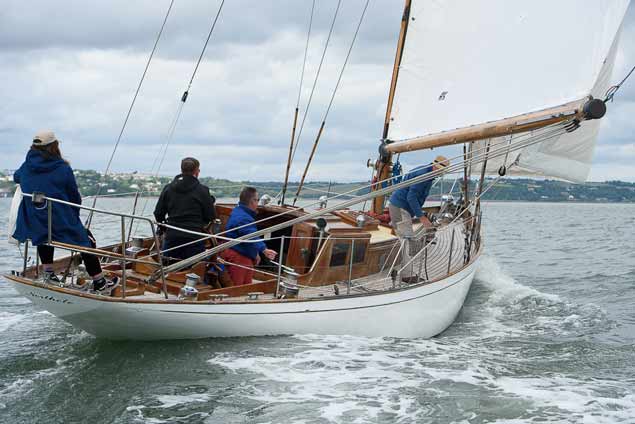 The sensibly wide and only very slightly cambered side decks (above and below) are a positive user-friendly feature of Northele’s design. Photos: Robert Bateman
The sensibly wide and only very slightly cambered side decks (above and below) are a positive user-friendly feature of Northele’s design. Photos: Robert Bateman
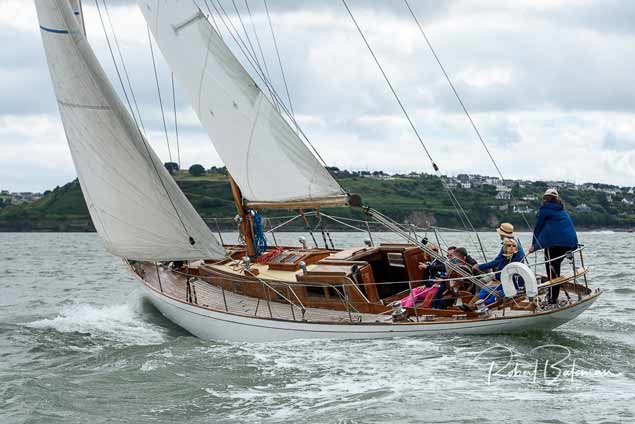
Everything about her was interesting, for not only did she reveal the designer’s classic style, but the experienced commissioning owner was Ronald R Burton who lived on the River Hamble - also in the Solent area, but at some distance from Lymington.
His previous boat had been the Sparkman & Stephens-designed International 8 Metre Iskareen, built in Sweden in 1939. But after World War II, the International 8 Metre Class, which had been a feature of the Solent in the 1930s, had melted away. So for a more suitable boat for the times, Burton decided to go to a place which wasn’t his home port despite the local proliferation of boatyards and designers on the Hamble, and get a boat from the new man just down from Scotland and working in Lymington.
The result was a fine yacht for which Berthon Boat Company were more than happy to claim all the credit, particularly as it was their careful saving of good timber which enabled Northele to be built at a time of post-war shortages, when quality seasoned timber was very scarce. In fact, in order to guarantee quality of construction, Northele was built to the detailed specification of the International 10 Metre Class. A proper racing 10 Metre would be approaching 60ft LOA, so when you build a cruiser-racer of 50 feet to the same spec, you get real strength and quality.
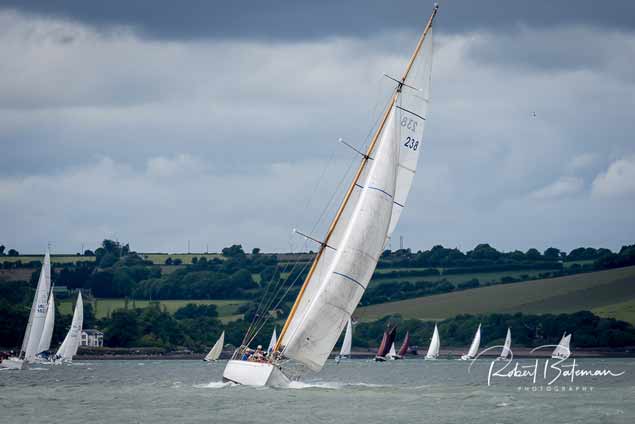 Even in a fleet of newer boats, Northele soon shows ahead of the pack. Photo: Robert Bateman
Even in a fleet of newer boats, Northele soon shows ahead of the pack. Photo: Robert Bateman
Sandy Balfour designed some other notable craft while he was with Berthon’s, but it was a busy yard in all areas and much of his energy was taken up with the day-to-day work this involved, while he was also an accredited Lloyds Surveyor. You sense a frustrated design talent. But a move to the Norfolk Broads to take over management of the J.Loynes & Son boatyard at Wroxham in the late 1950s was scarcely a step in the right direction, yet deep in the heart of Norfolk, and far from his native Scotland, there came an unexpected breakthrough.
In 1958, the Clyde Cruising Club, in association with the Glasgow Herald newspaper, launched a competition for an able sailing cruiser to cost not more than £1,000, a boat around 28ft which could comfortably take four people cruising at reasonable speeds and better off Scotland’s West Coast and through the Hebrides.
In the end, two transom-sterned designs – one by Sandy Balfour and the other by leading Burnham-on-Crouch-based independent designer Alan Buchanan – were assessed as being more or less equal on merit. But it was reckoned that Balfour’s Honeybee design would have difficulty staying within budget, so the result was Buchanan first, Balfour second.
Yet very few boats were to be built to the Buchanan design, but the Honeybee took off, with several builders producing many, the most prolific being a German company. And with each boat, A K Balfour was the properly accredited designer.
The Honeybee’s success makes you wonder how many other yachts of all sizes Sandy Balfour might have created, had circumstances been different. So as you cast an eye over the elegant and highly individual Northele sitting so gracefully in Crosshaven, remember that she is doubly precious – she is one of the few creations of a designer of a great but largely unfulfilled talent.
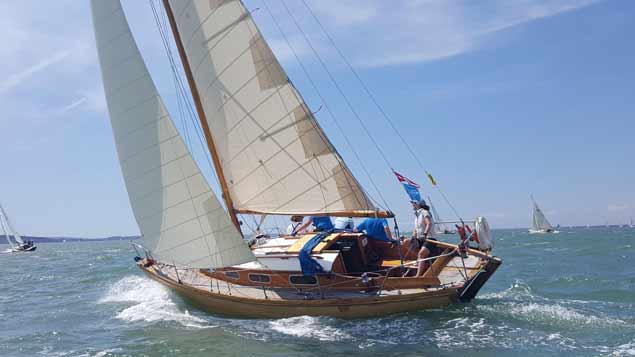 The Sandy Balfour-designed Honeybee Ragdoll on her way to a class victory in the Panerai British Classics Regatta. This successful design of 1958 proved to be particularly popular in Germany. Photo Fiona Brown
The Sandy Balfour-designed Honeybee Ragdoll on her way to a class victory in the Panerai British Classics Regatta. This successful design of 1958 proved to be particularly popular in Germany. Photo Fiona Brown


























